1. Describe the general morphology and anatomical location of the thymus.
Describe the source of the developing thymocytes (where did they come from).
Thymus location:
- Is above the heart and between the lungs
- Physical: cortex or cortical region, the medullary
Source of developing Thymocytes:
- thymocytes: are not yet T cells; they are developing T-cells
- Thymic epithelium: express both MHC I and MHC II
Describe the general organization of the TCR genes.
Describe the general principles of VDJ recombination of the TCR alpha and Beta chain genes. (Essentially the same as the VDJ recombination process that we learned for the immunoglobulin genes in B cells).
TCR: genes occur in the cortex of the thymus
VDJ Alpha Beta Chains:
- germline: Non Rearranged alpha and beta chains. this is the start
- PTalpha: surrogate this is Checkpoint 1
- TCR: This is checkpoint 2
- Beta chain rearrangement goes first then alpha chain rearrangement
Describe the structural properties of the pre-T cell receptor.
Explain the processes that occur after signaling through the pre-T cell receptor (1st checkpoint).
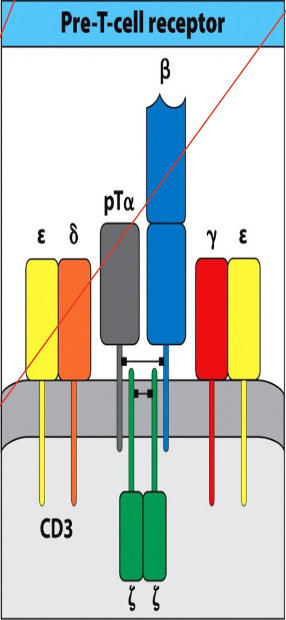
Structural Properties:
Process: 2 step process
- D beta-J beta rearrangement
- V beta-DJ beta rearrangement in frame.
- Beta chain protein produced.
Picture: structure of receptor at checkpoint 1
Describe the function of the various components of the T cell receptor. Describe the processes that occur after signaling through the T cell receptor (2nd checkpoint).
Functions:
Process after signaling:
Part 1 of process:
- surface expression of beta chain with surrogate alpha chain
- beta rearrangement stops
- cell proliferation
- CD4/CD8 induction
- alpha transcription starts
Part 2 of process:
- V alpha- J alpha rearrangement
- surface expression of alpha:beta:CD3
- selection can now begin
Picture: Structure of receptor at check point 2
Explain how multiple attempts can be made to productively rearrange the alpha and beta chain TCR genes.
Alpha chain: Can sustain many attempts at a functional rearrangement (the more it goes through the process the higher probability of success)
Beta: Two attempts can be made to achieve a productive rearrangement of the beta chain locus
Explain what is meant by describing a T cell as being double-negative, double-positive, or single-positive (reference is to status of CD4 and CD8 expression).
Double negative: Do not express CD8 and CD4
Double Positive: Express both CD8 and CD4
- now express an alpha/beta TCR that needs to be evaluated for proper function
Single Positive: Only express either CD8 or CD4
Describe the general meaning of an “activation threshold” for a T cell.
Activation Threshold:
- The activation threshold is the minimum signal intensity required for the probability of activation to be above zero, and it is defined by the addition of a fixed amount (the “critical perturbation”) to the baseline activity level.
Explain what property of the T cell is being tested during the process of positive selection. Explain what happens to T cells that pass or fail the positive selection step.
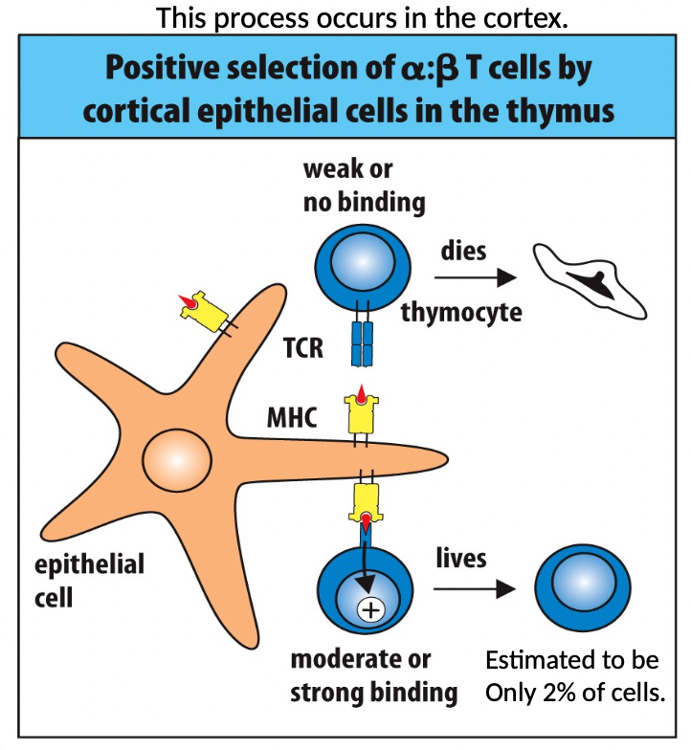
Property that is being tested:
- To determine if it will be able to function with self MHC of the body
- Selects for ability of TCR to interact with self MHC
- Cells lacking the ability to interact with self MHC die by apoptosis
Pass or Fail:
- Fail: if it does not reach positive selection threshold the cell dies by apoptosis
- Pass: they enter the goldi-lock zone (between pos. And neg. selection zone) or goes to neg. selection threshold where ( die by apoptosis or reprogrammed into regulatory Tcell[Treg])
Explain what property of the T cell is being tested during the process of negative selection. Explain what happens to T cells that pass or fail the negative selection step.
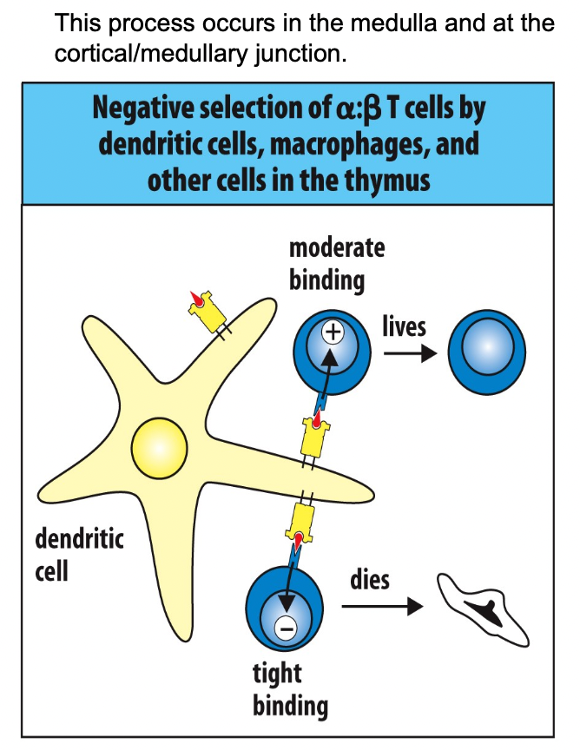
Negative Selection Properties:
- To determine if it's binds too strongly to self MHC in which case it would be autoreactive
- Selects against cells containing TCRs with high affinity for selfMHC or self MHC/peptide.
- Cells displaying high affinity for self MHC or self MHC and self peptides die by apoptosis
Pass Fail Neg. Selection Step:
- If the cells produced a TCR with too low affinity for self-MHC and failed
Explain the process that leads to a double-positive T cell becoming a single-positive T cell. What causes a double-positive T cell to become either a CD4+ Th cell or a CD8+ Tc cell?
Double Positive to Single Positive Tcell:
- this process occurs after the positive selection step in the cortex of the thymus.
Cause for double positive to be either CD4+(Thcell)or CD8+ (Tccell):
*this is affinity based
Explain where natural Tregs are produced. What phenotype did these cells have before they were changed into a Treg?
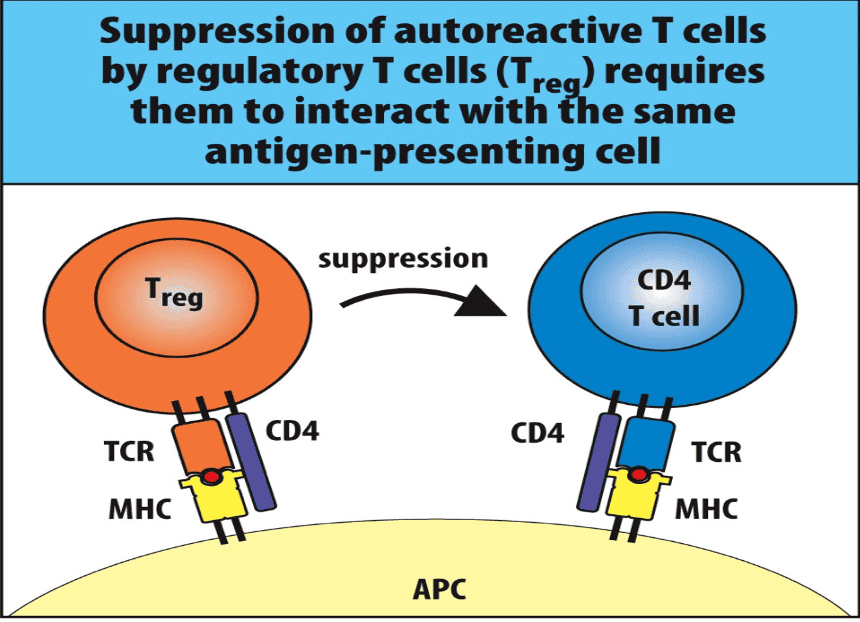
This is what happens to some of the cells that fail negative selection.
Produced:
- Some autoreactive CD4+ T cells develop into regulatory T cells (Treg) instead of undergoing apoptosis in the thymus.
- cells that are generated in the thymus during the process of T cell development
Phenotype before:
- Foxp3
Extra notes:
- Treg cells play an important role in controlling autoimmune responses by other CD4+ autoreactive T cells.
*Central Tolerance
Explain AIRE.
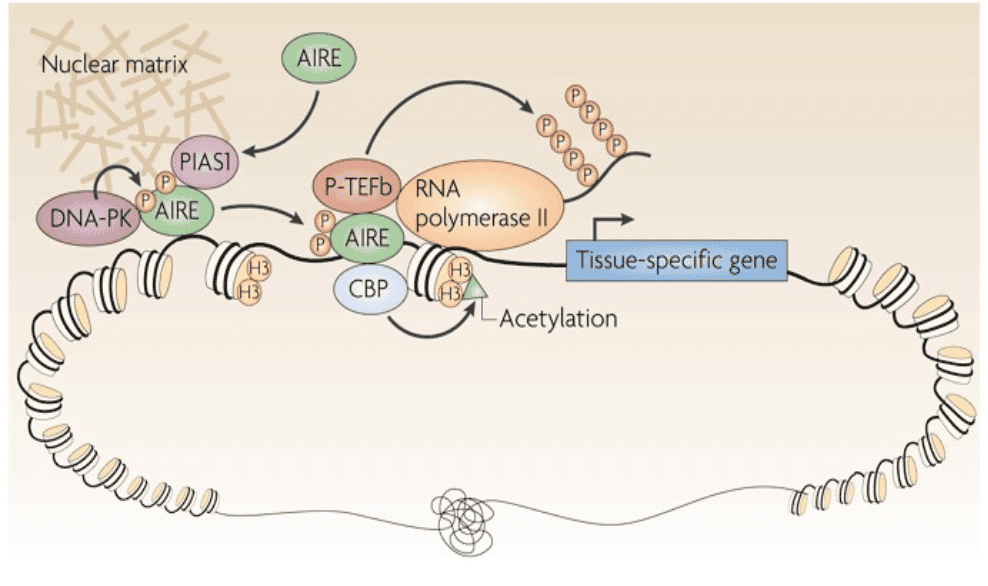
- Role of the AIRE transcription factor in the control of autoimmunity. AIRE = autoimmune regulator
- Note: Just focus on the big picture. AIRE induces the expression of tissue-specific genes within the medullary thymic epithelial cells, the cells that present MHC/peptide to developing T cells. This helps to identify T cells with TCRs expressing high affinity to self antigens expressed by tissues outside of the thymus.
A single developing T cell passes checkpoint #1 but does not pass checkpoint #2. Which one of the following statements about this cell is false?
a.) This cell is equally likely to become a Th as it is to become a Tc.
b.) This cell successfully expressed a TCR beta chain protein.
c.) This cell expresses both CD4 and CD8 on its surface (it is double positive).
d.) This cell did express a functional Pre-T cell receptor.eThis cell will not leave the thymus.
a.) This cell is equally likely to become a Th as it is to become a Tc.
A newly developed T cell dies by apoptosis if it does not display enough affinity for any MHC/peptide being presented in the thymus (cell fails positive selection). True/False: This exact same T cell may have passed positive selection if it had developed in the thymus of a different individual.
True
You develop a strain of mouse that lacks a functional AIRE gene. True/False: This mouse would not be able to experience an autoimmune disease.
False
A protein called FOXP3 is required to produce a Treg. A strain of mouse has been developed that does not have a functional FOXP3 gene, and this mouse cannot produce Tregs. True/False: This strain of mouse is highly susceptible to microbial infections.
False